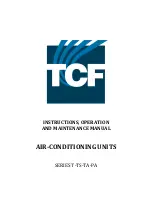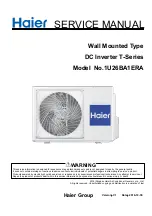
60
Marvair GAA A/C w/Gas Heat I&O Manual
06/2023 Rev.5
WARNING
CARBON MONOXIDE POISONING
A crack or hole in the heat exchanger could result in carbon monoxide gas which can cause death or serious
injury. Carbon monoxide is colorless and odorless. Signs that there is a hole or crack in the heat exchanger
include:
• Headaches, Nausea or Dizziness.
• Excessive humidity or heavily frosted windows or a clammy feeling in the structure.
AVERTISSEMENT
EMPOISONNEMENT AU MONOXYDE DE CARBONE
Une fissure ou un trou dans l’échangeur thermique peut laisser échapper du gaz avec monoxyde de carbone
qui peut causer des troubles sévères ou mortels. Le monoxyde de carbone est sans couleur et sans odeur.
Les signes pouvant indiquer un problème d’étanchéité sur l’échangeur thermique sont :
1. Maux de tête, nausées ou vertiges.
2. Humidité excessive ou fenêtres très givrées, ou viscosité sur la structure.
7.6 Drains
Regularly check the primary and secondary condensate drains. The secondary drain has a stand
pipe. An obstruction will force water to dump into the middle of the unit and drain out the sides of the
air conditioner, causing discoloration of the side panels. If discoloration is noted, service the drains.
If a commercial drain solvent is used, flush out the drain pan and system with plenty of fresh water
to prevent corrosion.
7.7 Lubrication
Oiling of the condenser fan motor or the evaporator blower motor is not recommended.
7.8 Burner Flame
Inspect the burner flame periodically during the heating season to ensure proper burner operation.
Light the burners and allow the unit to operate for a few minutes to establish normal burning conditions.
Look at the flames on the burners. They should be predominately blue in color and robust in appearance.
The flame should be in the middle of the heat exchanger tubes. Check to see that all the burners are lit
and that the flame does not impinge on the sides of the heat exchanger. Observe the flame. There should
be little or no change to in the shape or size of the flame. Changes in the shape and size of the flame may
indicate a leak in the heat exchanger. See Figure 3.
Figure 13. Burner Flame





































